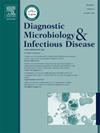提高内脏利什曼病的诊断准确性:基于嵌合蛋白的方法
IF 2.1
4区 医学
Q3 INFECTIOUS DISEASES
Diagnostic microbiology and infectious disease
Pub Date : 2025-06-11
DOI:10.1016/j.diagmicrobio.2025.116948
引用次数: 0
摘要
人类内脏利什曼病(HVL)是巴西的一种特有疾病,由婴儿利什曼原虫引起,由沙蝇传播,其特点是一系列复杂且经常重叠的症状,包括持续发热、体重减轻、器官肿大、贫血和出血。HVL的诊断过程经常受到疾病的非特异性临床表现和现有血清学检测的固有局限性的阻碍,血清学检测通常表现出不理想的敏感性和特异性,容易导致诊断不准确。在巴西,开发敏感和特异的诊断方法对于有效控制HVL至关重要,这有助于早期发现疾病并改善治疗结果。为了提高诊断能力,我们评估了通过免疫蛋白组学分析鉴定的b淋巴细胞表位设计的嵌合蛋白在检测婴儿乳杆菌感染的血清学试验中的性能。在实验条件下,嵌合蛋白对对照样品的特异性为100%,对恰加斯病样品的特异性为94.12%,对hvl阳性个体的敏感性为100%。受试者工作特征(ROC)曲线分析显示:曲线下面积(AUC)为0.9960,灵敏度为100%,总特异性为97.10%,显著优于婴儿乳杆菌可溶性抗原(SLiA) ELISA。这些发现表明,嵌合蛋白代表了一种有希望的抗原,可用于开发改进的HVL诊断技术,有可能减少该疾病对公共卫生的影响。本文章由计算机程序翻译,如有差异,请以英文原文为准。
Improving diagnostic accuracy in visceral leishmaniasis: Chimeric protein-based approach
Endemic to Brazil, Human Visceral Leishmaniasis (HVL), caused by Leishmania infantum and vectored by sand flies, is characterized by a complex and often overlapping set of symptoms, including prolonged fever, weight loss, organomegaly, anaemia, and bleeding. The diagnostic process for HVL is frequently hindered by the disease's nonspecific clinical presentation and the inherent limitations of existing serological assays, which often exhibit suboptimal sensitivity and specificity, predisposing to diagnostic inaccuracies. Developing of sensitive and specific diagnostic assays is crucial for effective HVL control in Brazil, enabling early disease detection and improving treatment outcomes. To enhance diagnostic capabilities, we evaluated the performance of a chimeric protein designed from B-lymphocyte cell epitopes identified through immunoproteomic analysis in serological tests for detecting L. infantum infection. Under the experimental conditions, the chimeric protein demonstrated the following diagnostic performance: 100 % specificity against control samples, 94.12 % specificity against Chagas disease samples, and 100 % sensitivity for HVL-positive individuals. Receiver Operating Characteristic (ROC) curve analysis demonstrated the following performance metrics: area under the curve (AUC) of 0.9960, 100 % sensitivity, and 97.10 % overall specificity, significantly exceeding the performance of the L. infantum soluble antigen (SLiA) ELISA. These findings suggest that the chimeric protein represents a promising antigen for developing of improved HVL diagnostic technologies, potentially reducing the disease's public health impact.
求助全文
通过发布文献求助,成功后即可免费获取论文全文。
去求助
来源期刊
CiteScore
5.30
自引率
3.40%
发文量
149
审稿时长
56 days
期刊介绍:
Diagnostic Microbiology and Infectious Disease keeps you informed of the latest developments in clinical microbiology and the diagnosis and treatment of infectious diseases. Packed with rigorously peer-reviewed articles and studies in bacteriology, immunology, immunoserology, infectious diseases, mycology, parasitology, and virology, the journal examines new procedures, unusual cases, controversial issues, and important new literature. Diagnostic Microbiology and Infectious Disease distinguished independent editorial board, consisting of experts from many medical specialties, ensures you extensive and authoritative coverage.

 求助内容:
求助内容: 应助结果提醒方式:
应助结果提醒方式:


